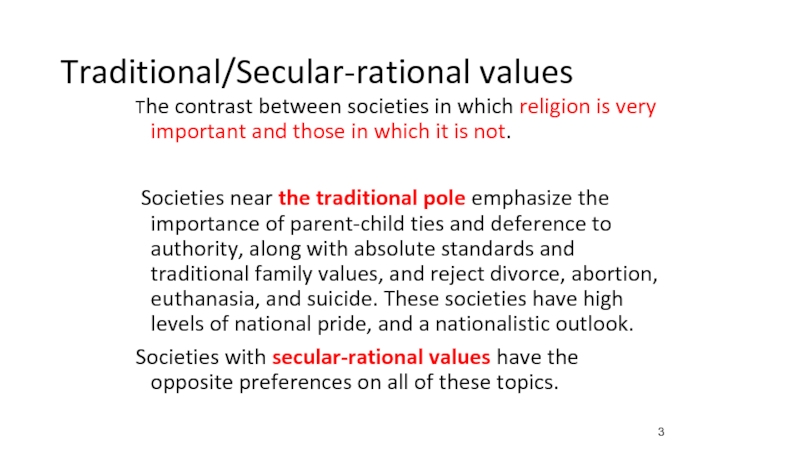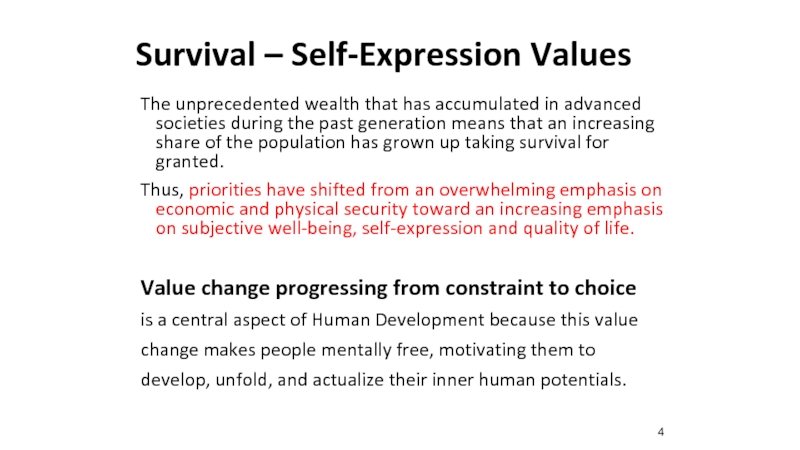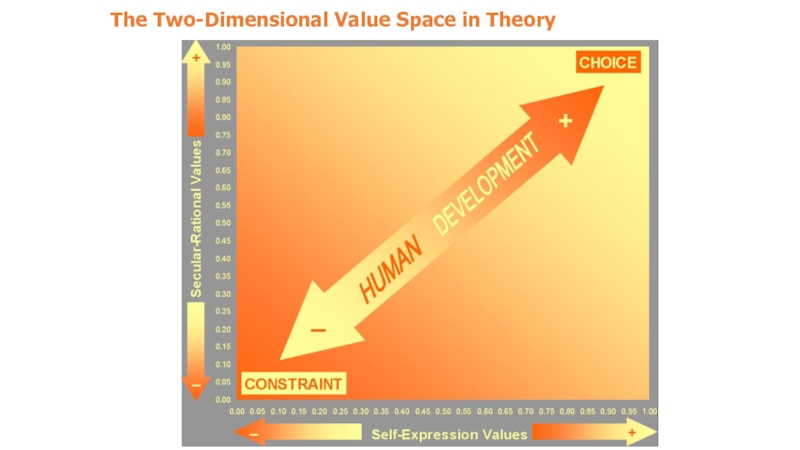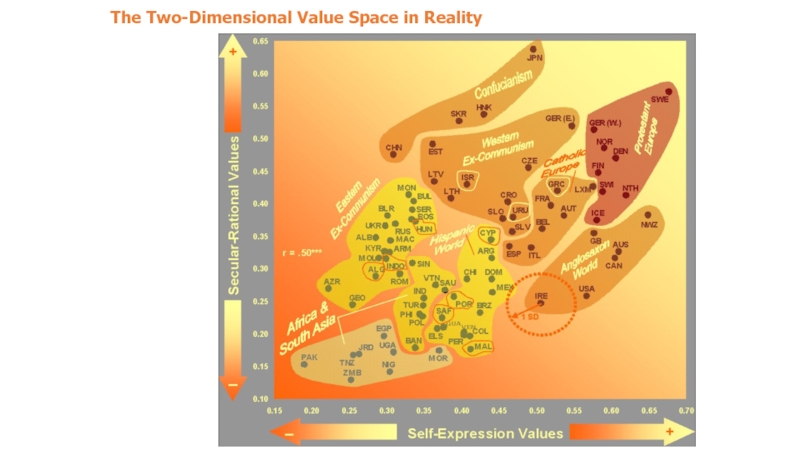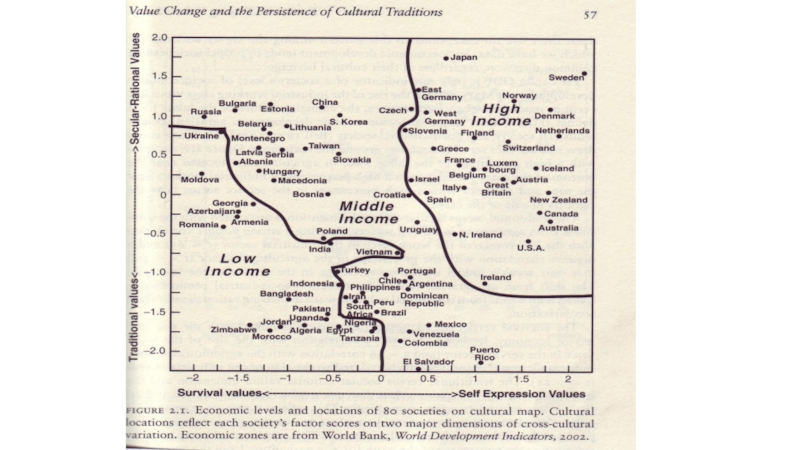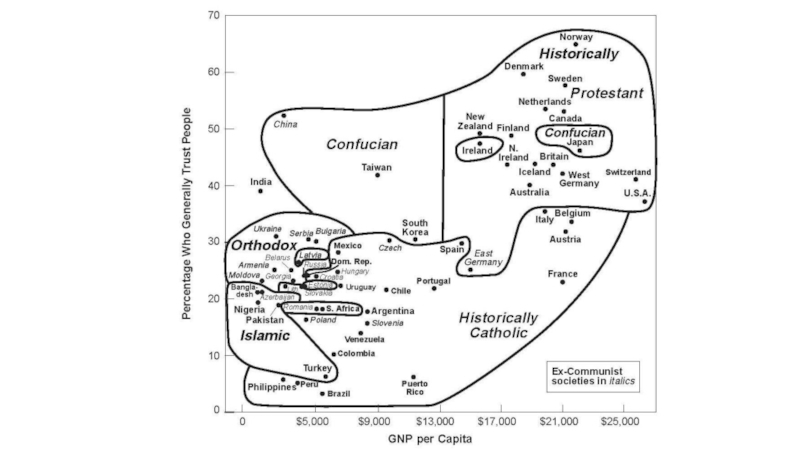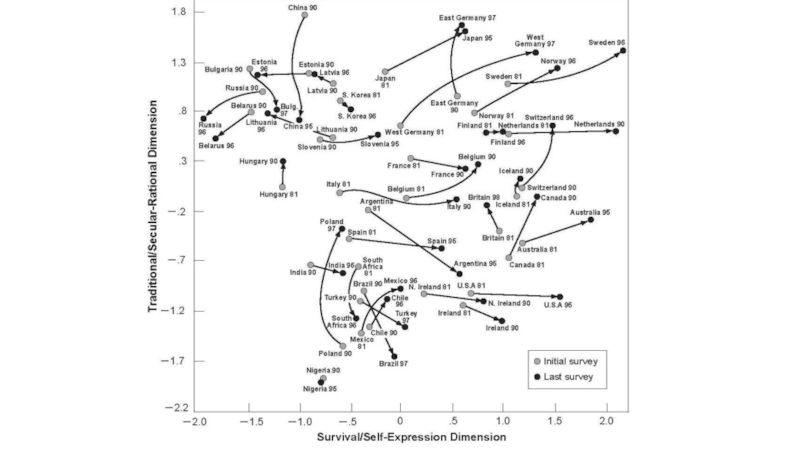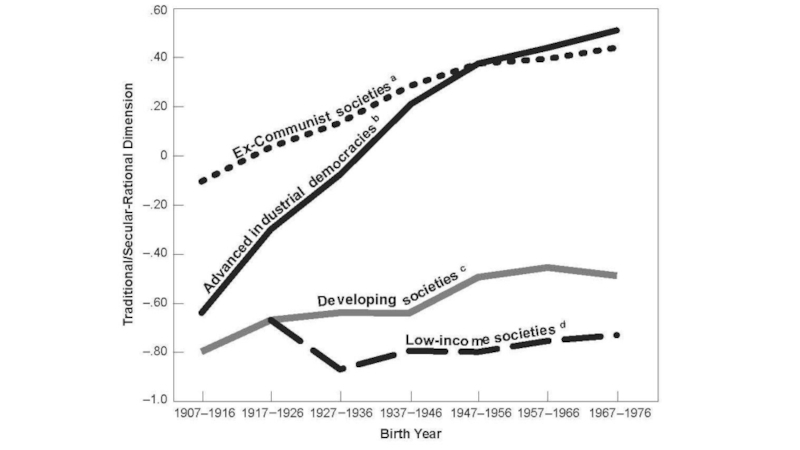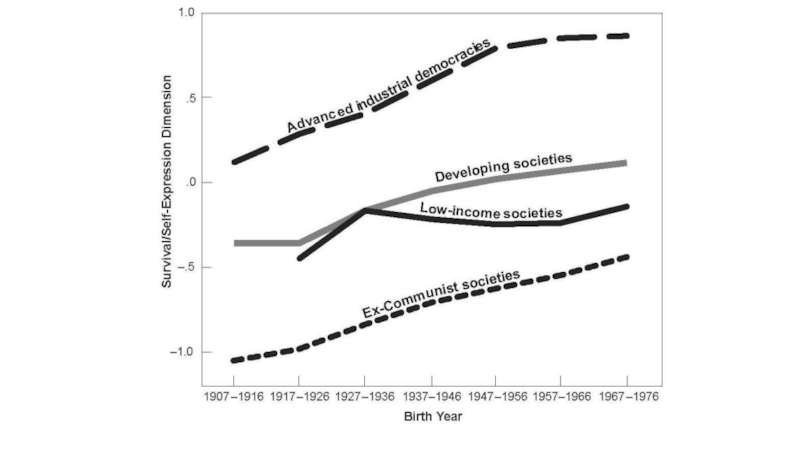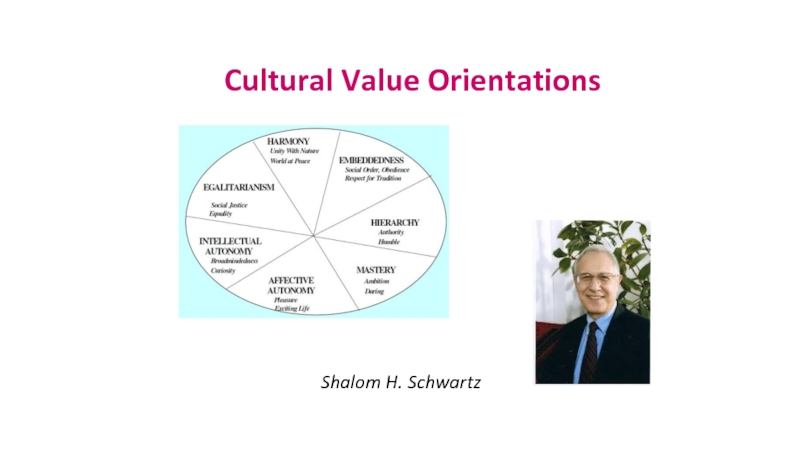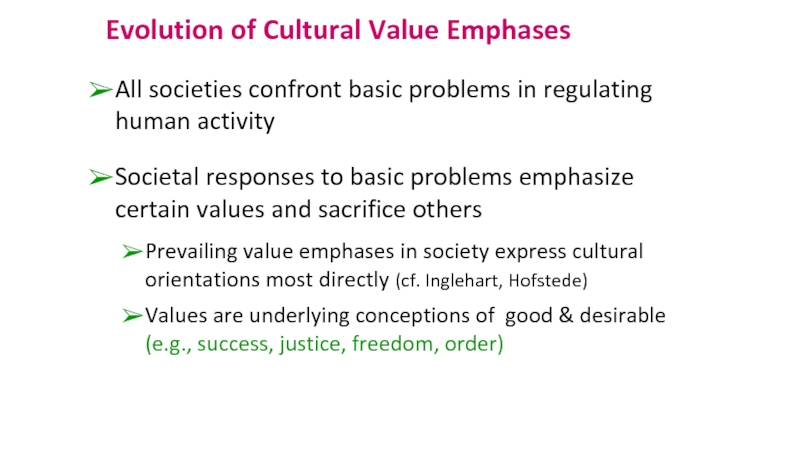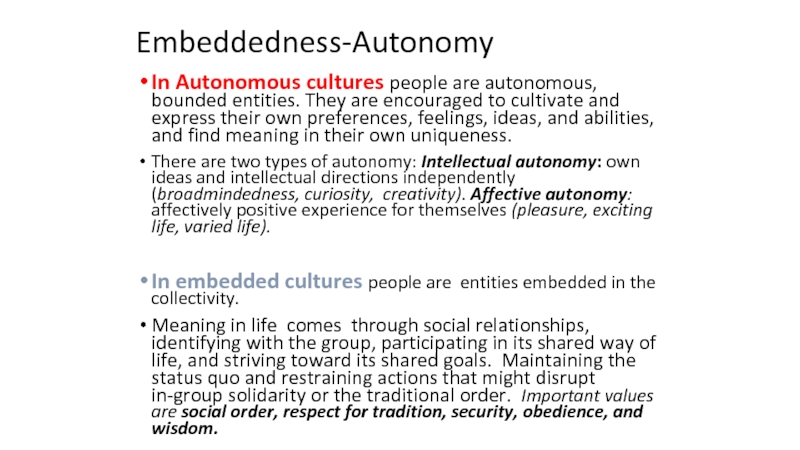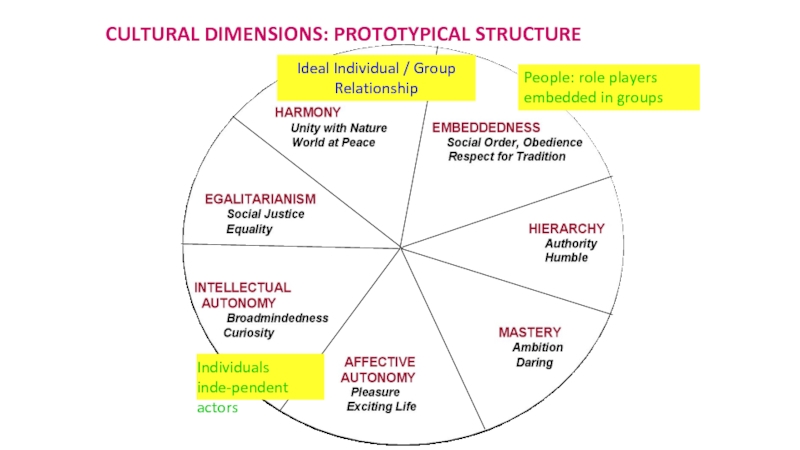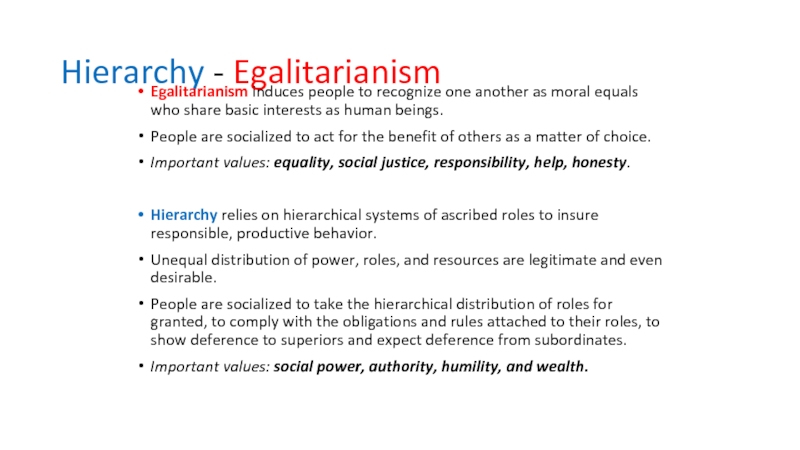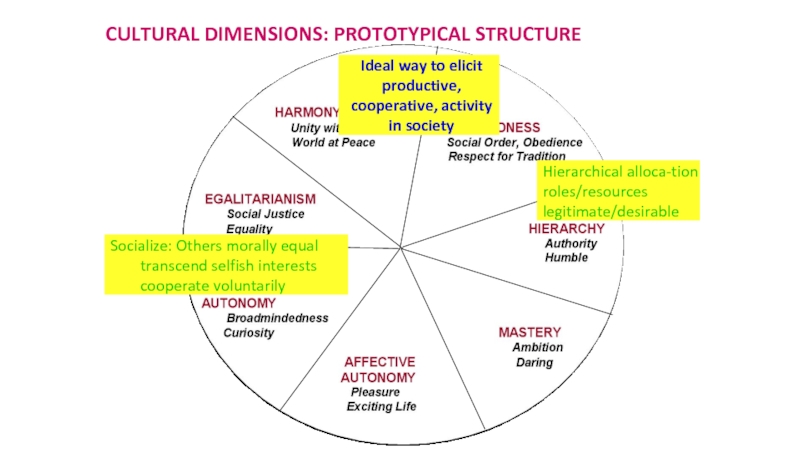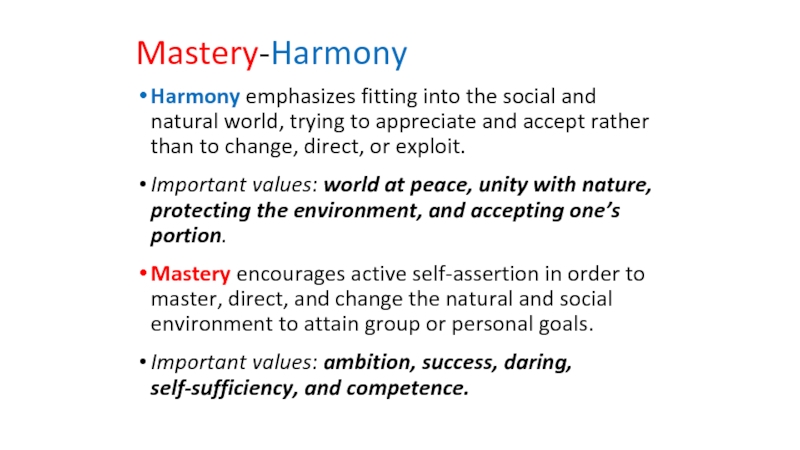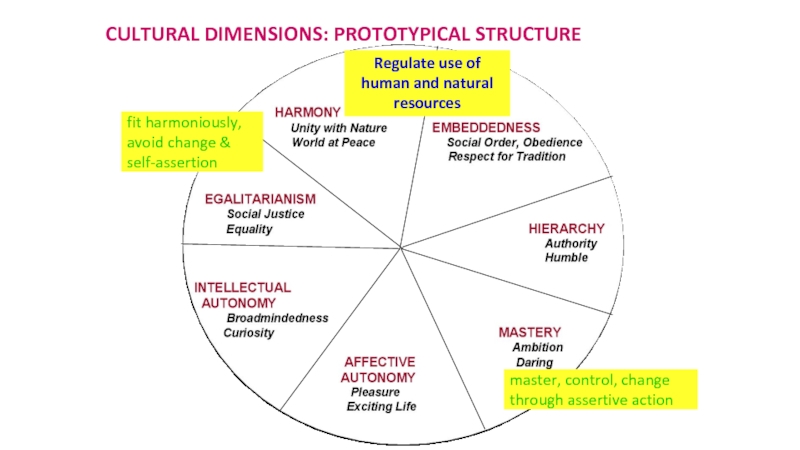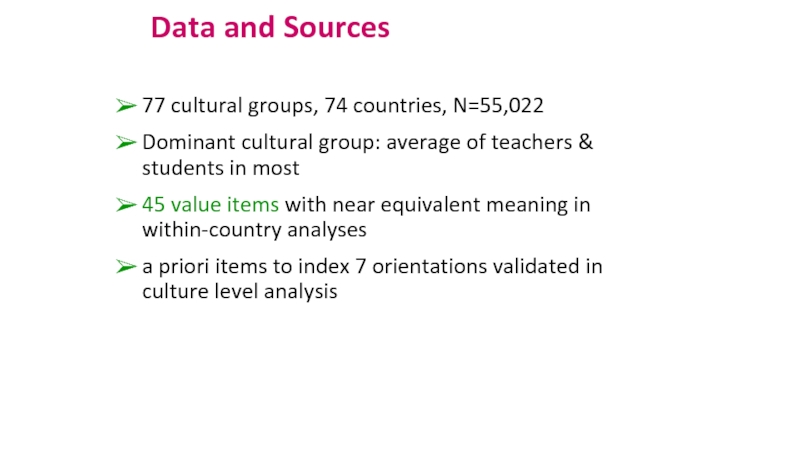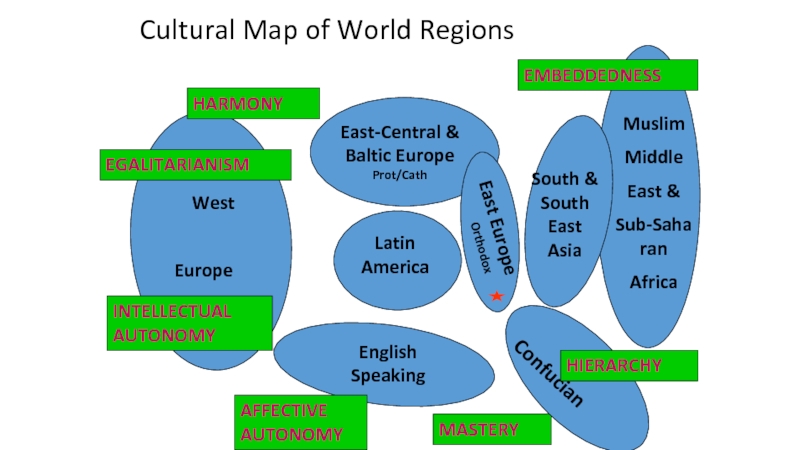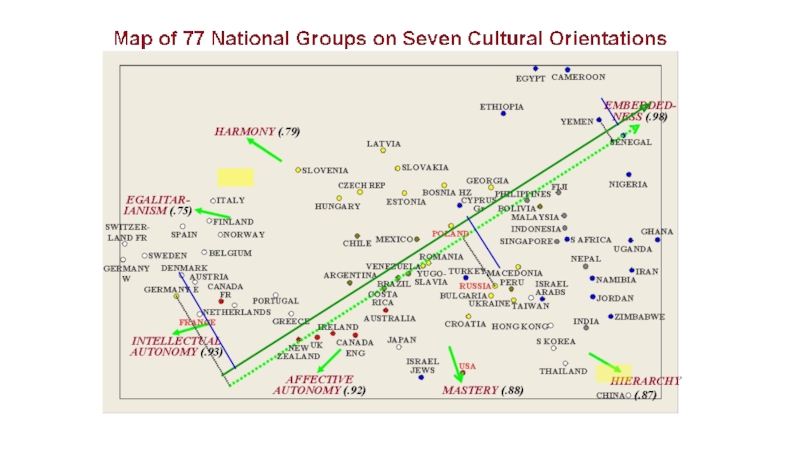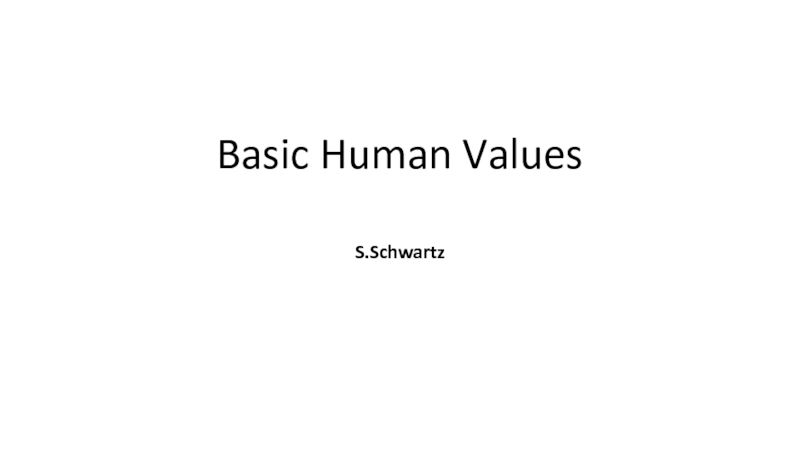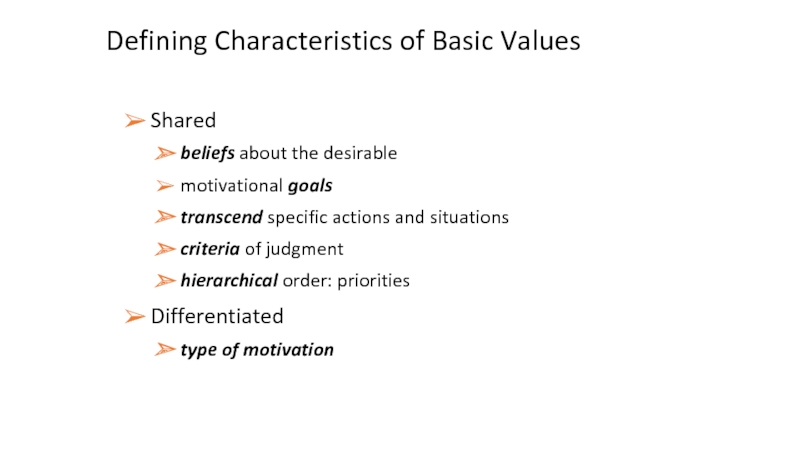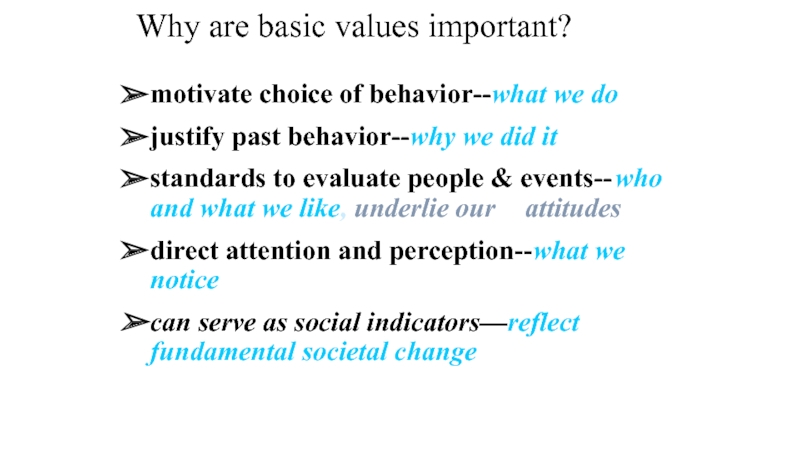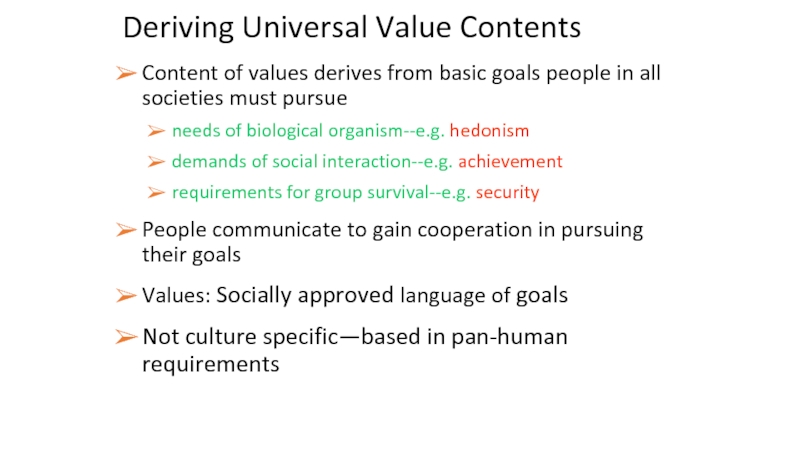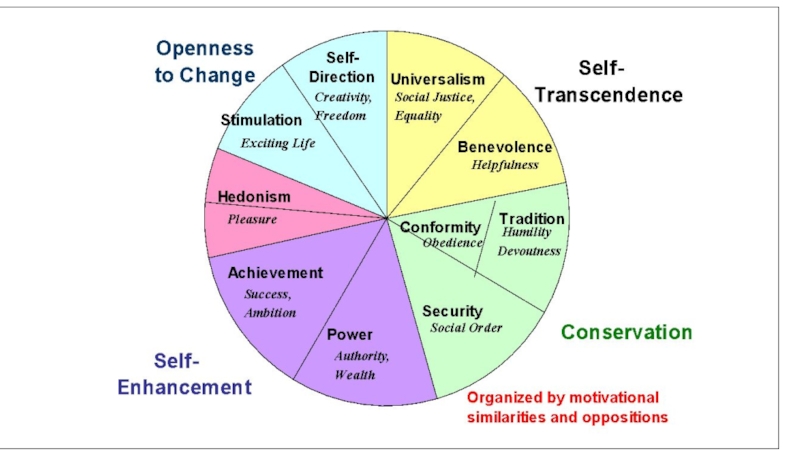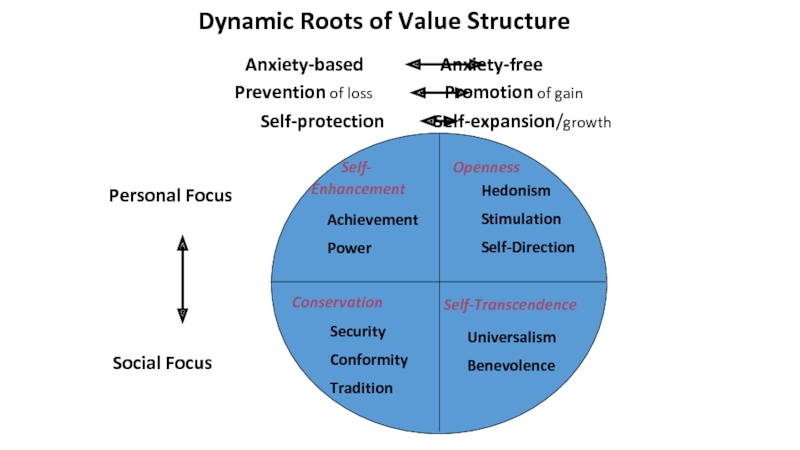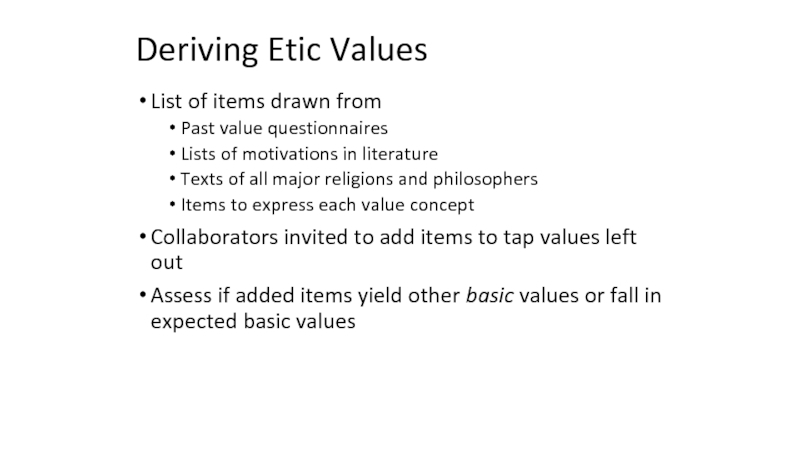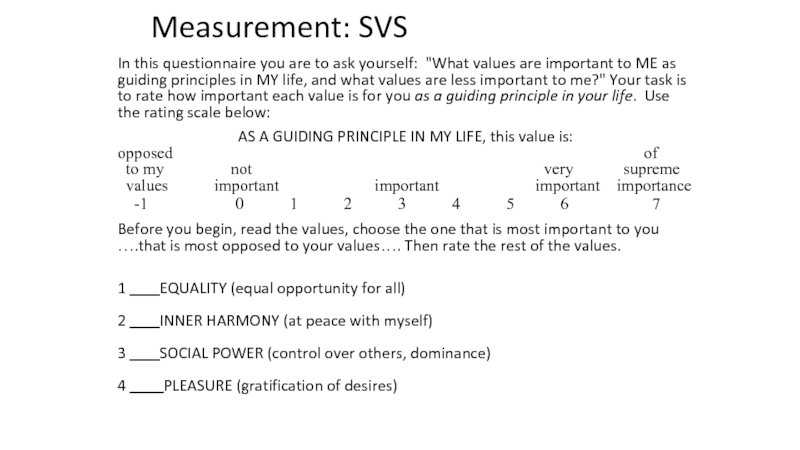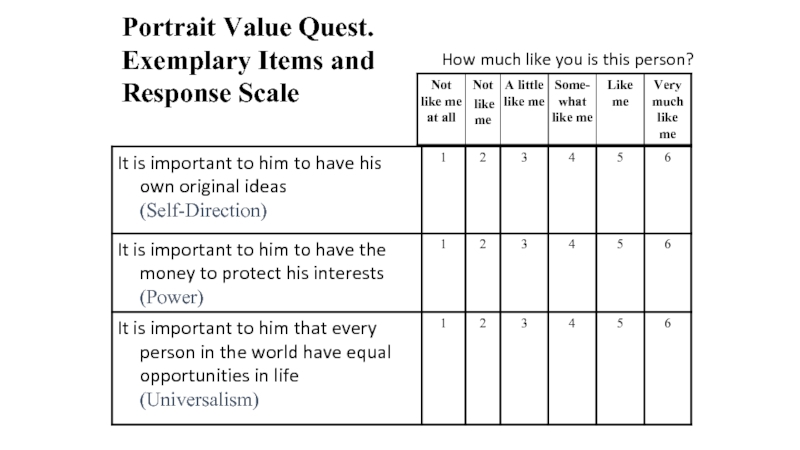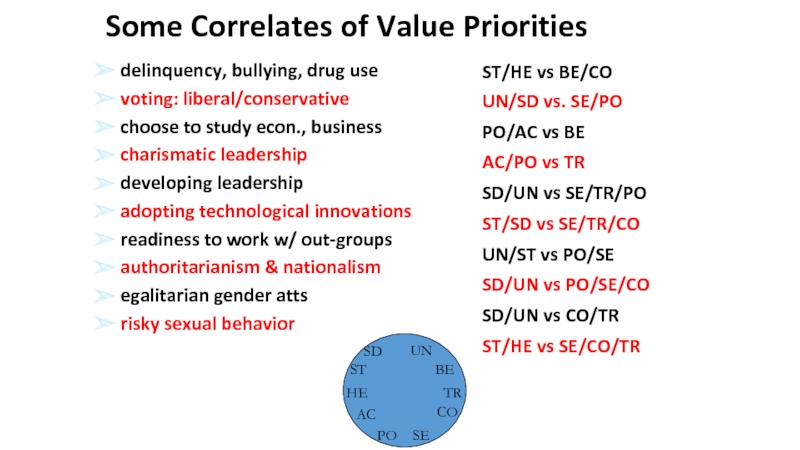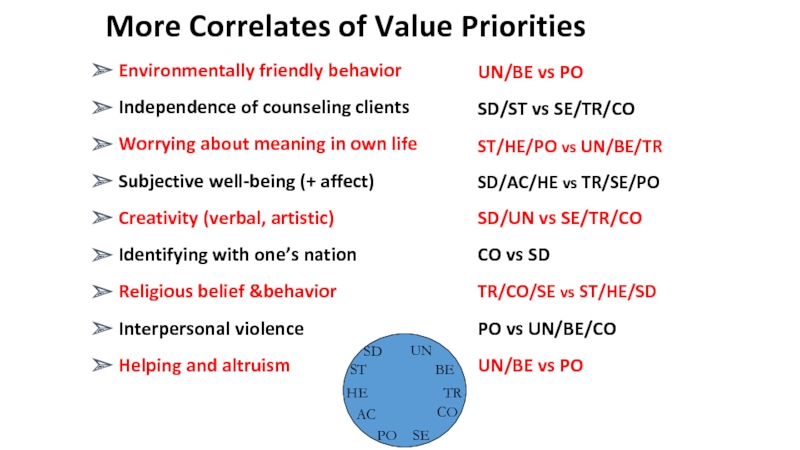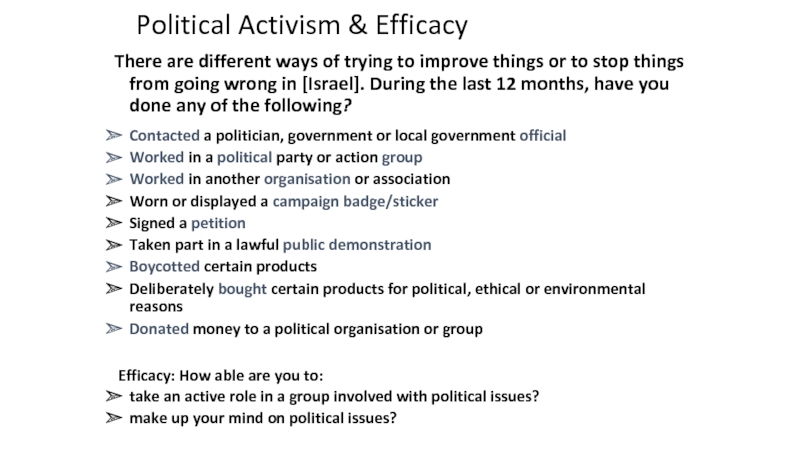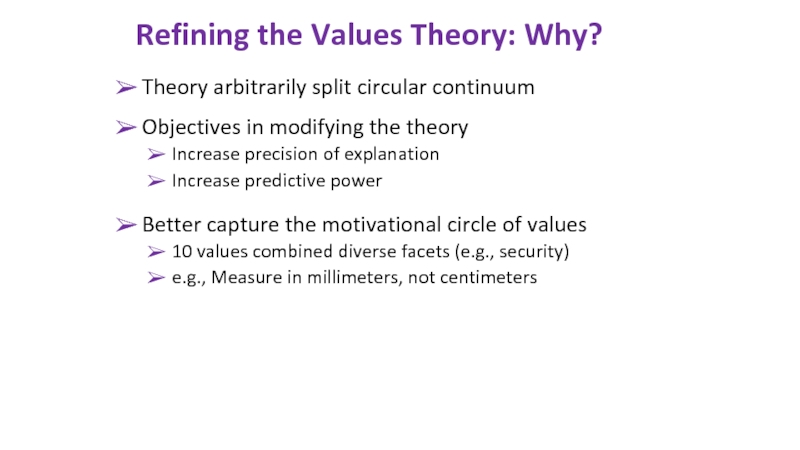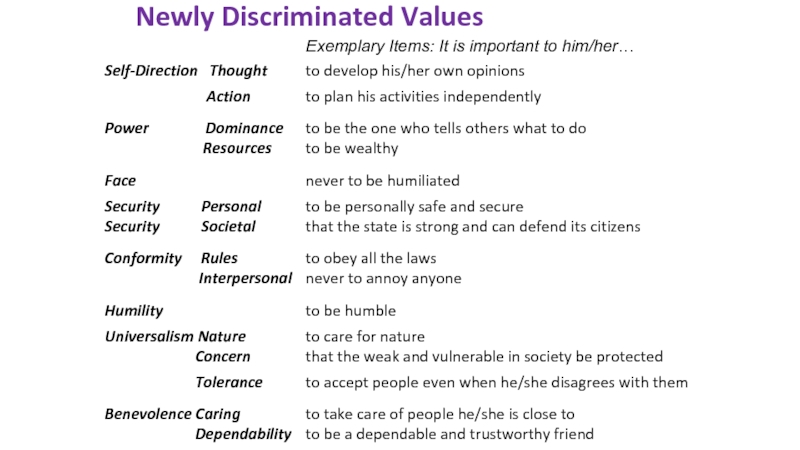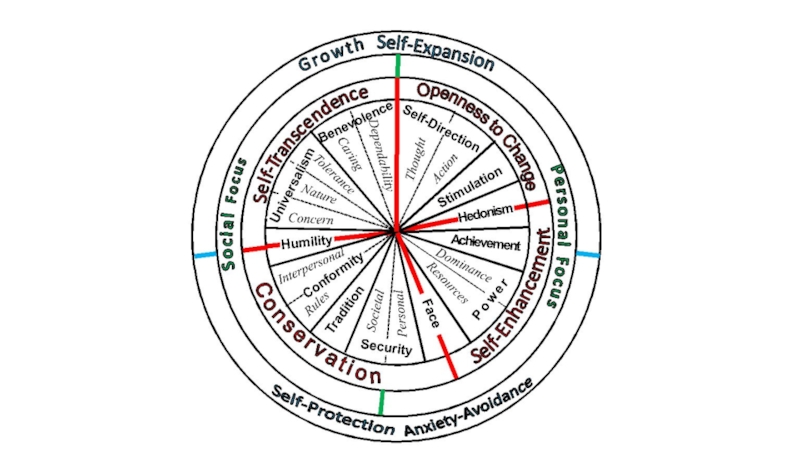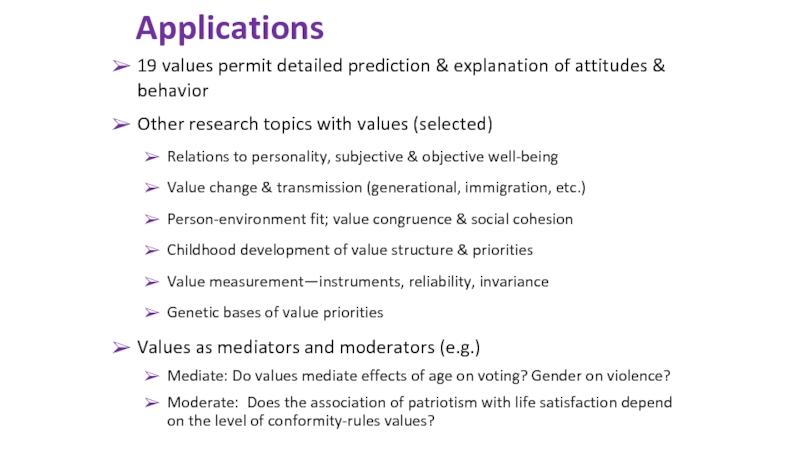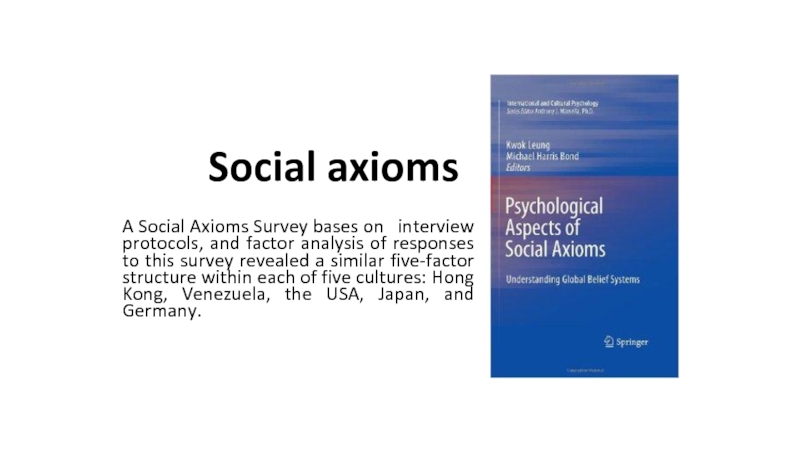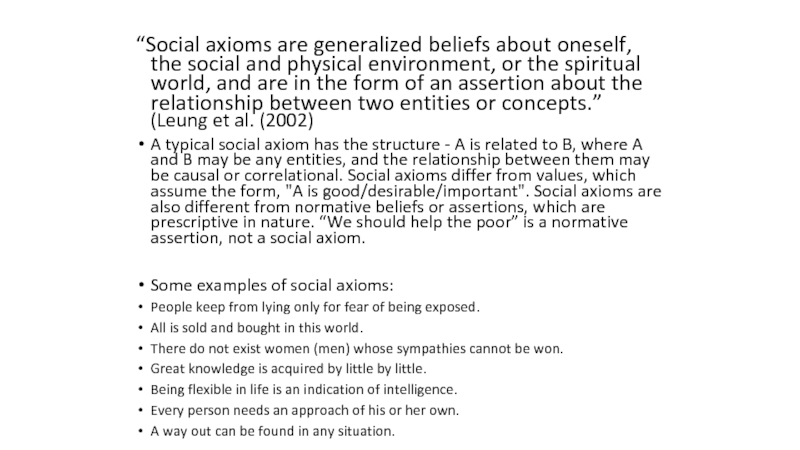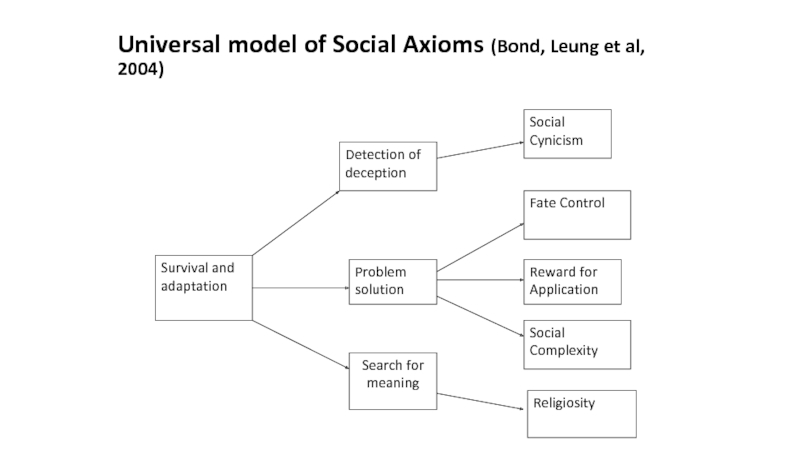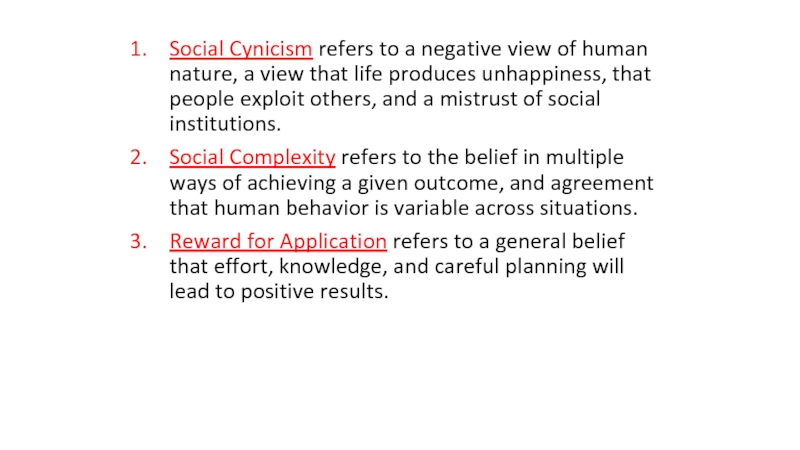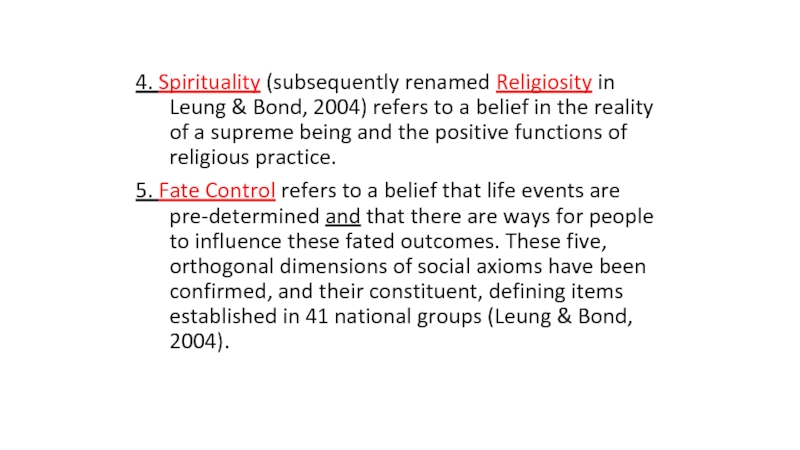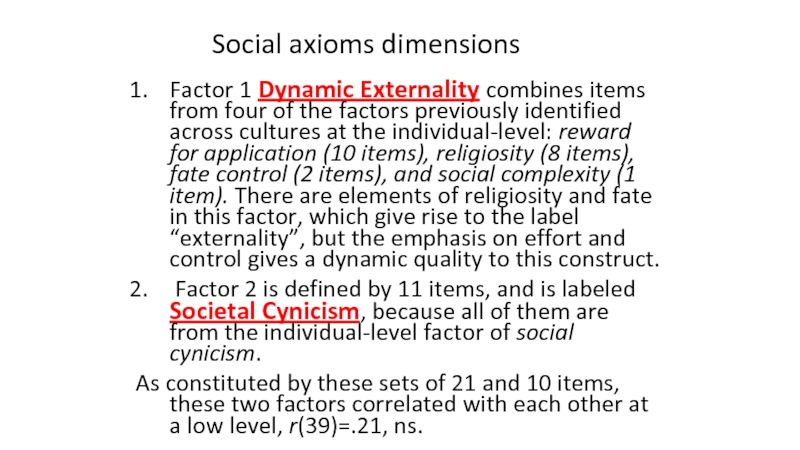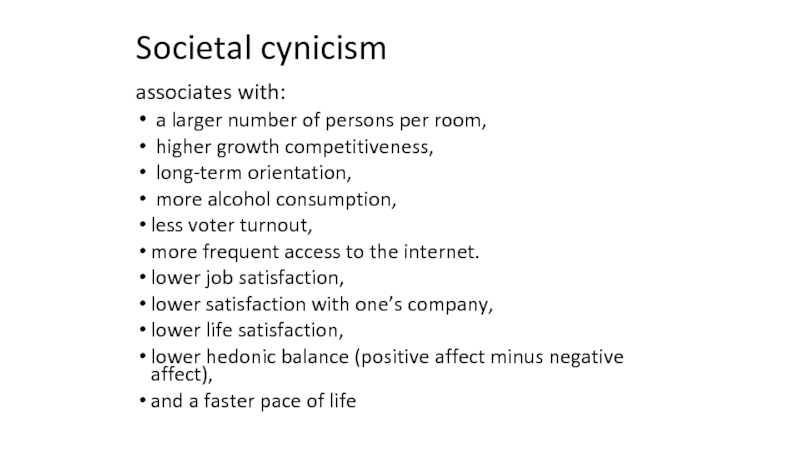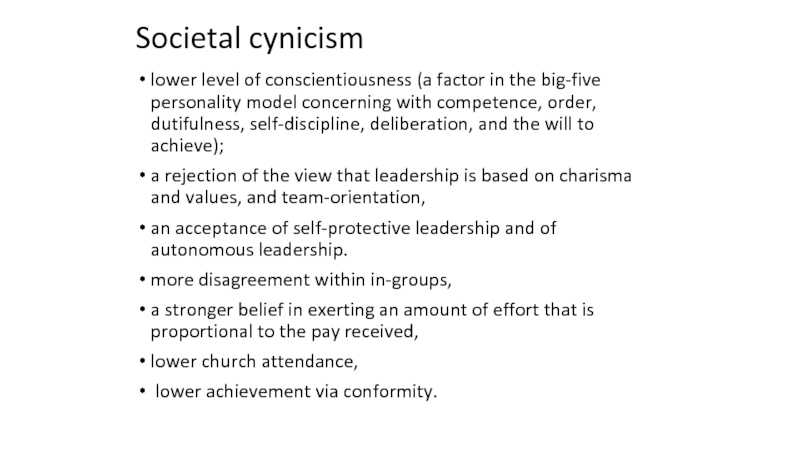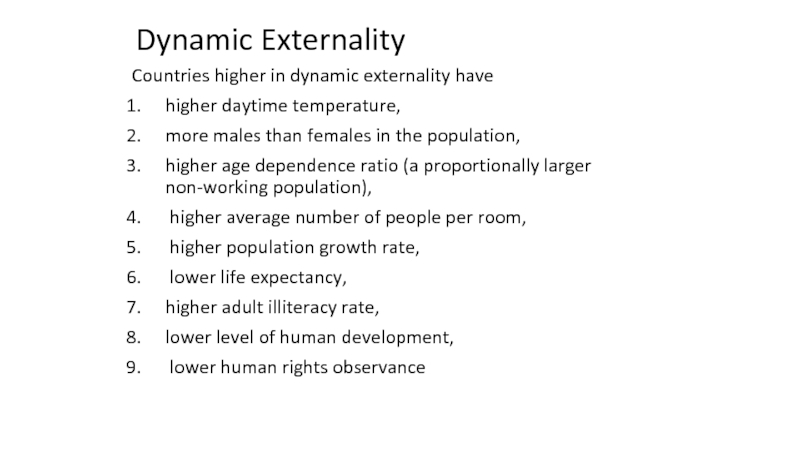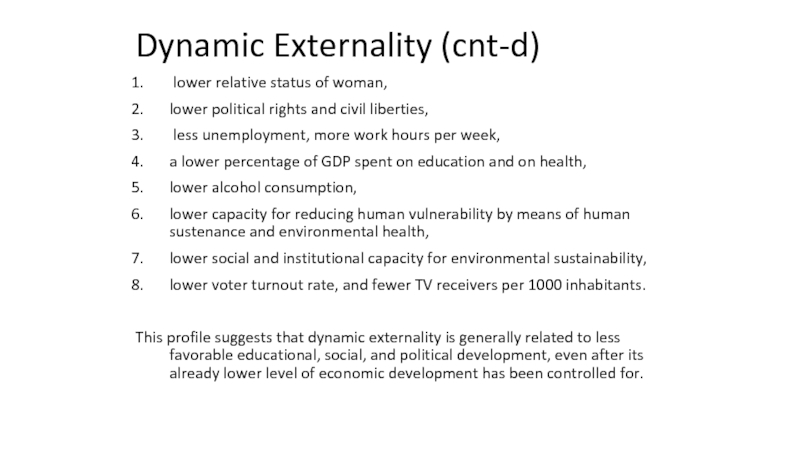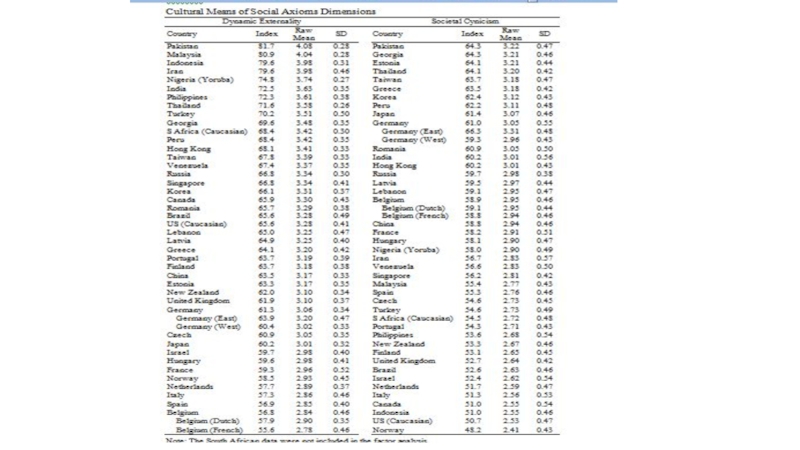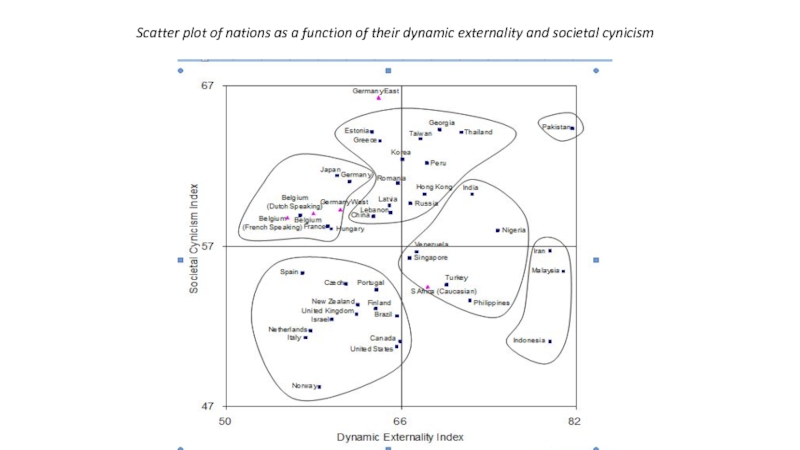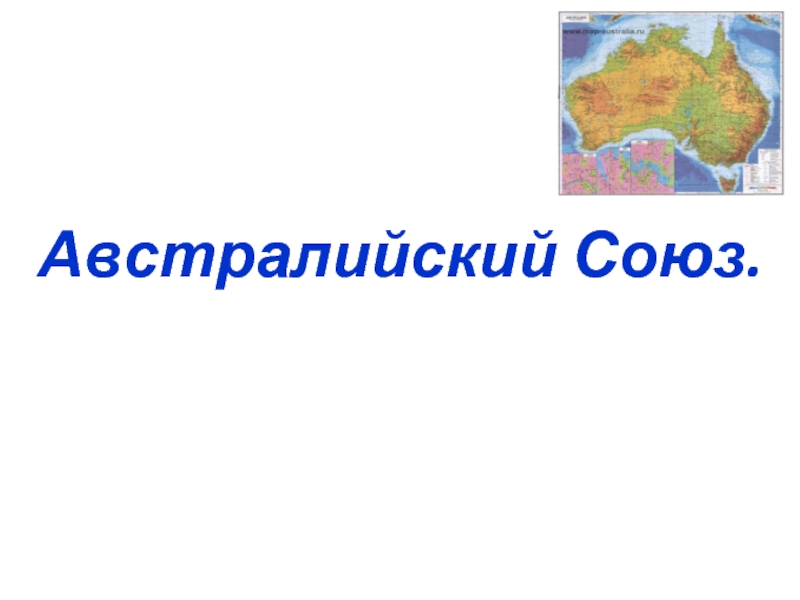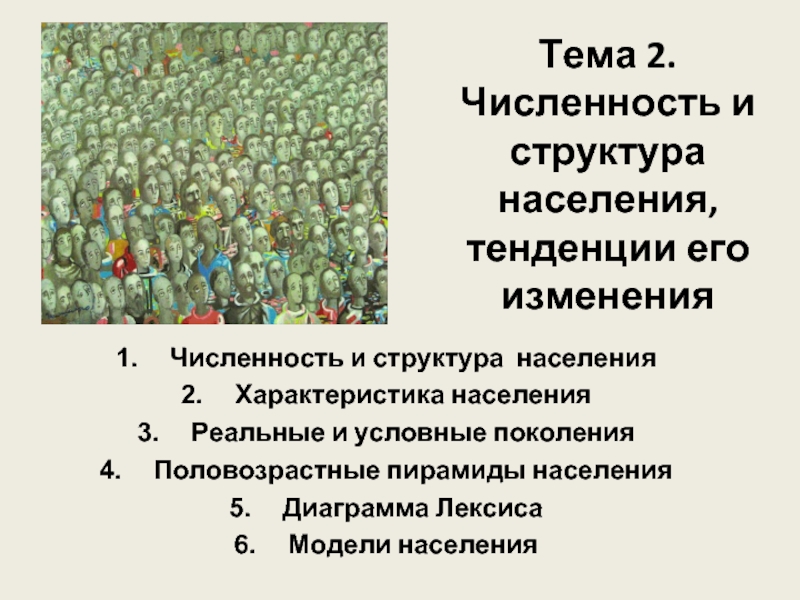- Главная
- Разное
- Дизайн
- Бизнес и предпринимательство
- Аналитика
- Образование
- Развлечения
- Красота и здоровье
- Финансы
- Государство
- Путешествия
- Спорт
- Недвижимость
- Армия
- Графика
- Культурология
- Еда и кулинария
- Лингвистика
- Английский язык
- Астрономия
- Алгебра
- Биология
- География
- Детские презентации
- Информатика
- История
- Литература
- Маркетинг
- Математика
- Медицина
- Менеджмент
- Музыка
- МХК
- Немецкий язык
- ОБЖ
- Обществознание
- Окружающий мир
- Педагогика
- Русский язык
- Технология
- Физика
- Философия
- Химия
- Шаблоны, картинки для презентаций
- Экология
- Экономика
- Юриспруденция
Measuring and mapping cultures презентация
Содержание
- 1. Measuring and mapping cultures
- 2. Ronald Inglehart
- 3. Traditional/Secular-rational values The contrast between societies
- 4. Survival – Self-Expression Values The unprecedented wealth
- 5. The Two-Dimensional Value Space in Theory
- 6. The Two-Dimensional Value Space in Reality
- 12. Cultural Value Orientations Shalom H. Schwartz
- 13. All societies confront basic problems in regulating
- 14. Embeddedness-Autonomy In Autonomous cultures people are autonomous,
- 15. CULTURAL DIMENSIONS: PROTOTYPICAL STRUCTURE Ideal Individual /
- 16. Hierarchy - Egalitarianism Egalitarianism induces people to
- 17. CULTURAL DIMENSIONS: PROTOTYPICAL STRUCTURE Ideal way to
- 18. Mastery-Harmony Harmony emphasizes fitting into the social
- 19. CULTURAL DIMENSIONS: PROTOTYPICAL STRUCTURE Regulate use of
- 20. Data and Sources 77 cultural groups, 74
- 21. Cultural Map of World Regions MASTERY
- 23. Basic Human Values S.Schwartz
- 24. Defining Characteristics of Basic Values Shared
- 25. Why are basic values important? motivate
- 26. Deriving Universal Value Contents Content of values
- 28. Prevention of loss
- 29. Deriving Etic Values List of items drawn
- 30. Measurement: SVS In this questionnaire you are
- 31. Portrait Value Quest. Exemplary Items and Response Scale How much like you is this person?
- 32. Some Correlates of Value Priorities delinquency, bullying,
- 33. More Correlates of Value Priorities Environmentally friendly
- 34. Political Activism & Efficacy There are different
- 35. Values Value Predictions?
- 36. Refining the Values Theory: Why? Theory arbitrarily
- 37. Newly Discriminated Values
- 39. Applications 19 values permit detailed prediction &
- 40. Social axioms A Social Axioms Survey bases
- 41. “Social axioms are generalized beliefs about
- 42. Universal model of Social Axioms (Bond, Leung et al, 2004) Religiosity
- 43. Social Cynicism refers to a negative view
- 44. 4. Spirituality (subsequently renamed Religiosity in
- 45. Factor 1 Dynamic Externality combines items from
- 46. Societal cynicism associates with: a larger
- 47. Societal cynicism lower level of conscientiousness (a
- 48. Dynamic Externality Countries higher in dynamic externality
- 49. Dynamic Externality (cnt-d) lower relative status
- 51. Scatter plot of nations as a function of their dynamic externality and societal cynicism
Слайд 3Traditional/Secular-rational values
The contrast between societies in which religion is very
Societies near the traditional pole emphasize the importance of parent-child ties and deference to authority, along with absolute standards and traditional family values, and reject divorce, abortion, euthanasia, and suicide. These societies have high levels of national pride, and a nationalistic outlook.
Societies with secular-rational values have the opposite preferences on all of these topics.
Слайд 4Survival – Self-Expression Values
The unprecedented wealth that has accumulated in advanced
Thus, priorities have shifted from an overwhelming emphasis on economic and physical security toward an increasing emphasis on subjective well-being, self-expression and quality of life.
Value change progressing from constraint to choice
is a central aspect of Human Development because this value
change makes people mentally free, motivating them to
develop, unfold, and actualize their inner human potentials.
Слайд 13All societies confront basic problems in regulating human activity
Societal responses to
Prevailing value emphases in society express cultural orientations most directly (cf. Inglehart, Hofstede)
Values are underlying conceptions of good & desirable (e.g., success, justice, freedom, order)
Evolution of Cultural Value Emphases
Слайд 14Embeddedness-Autonomy
In Autonomous cultures people are autonomous, bounded entities. They are encouraged
There are two types of autonomy: Intellectual autonomy: own ideas and intellectual directions independently (broadmindedness, curiosity, creativity). Affective autonomy: affectively positive experience for themselves (pleasure, exciting life, varied life).
In embedded cultures people are entities embedded in the collectivity.
Meaning in life comes through social relationships, identifying with the group, participating in its shared way of life, and striving toward its shared goals. Maintaining the status quo and restraining actions that might disrupt in-group solidarity or the traditional order. Important values are social order, respect for tradition, security, obedience, and wisdom.
Слайд 15CULTURAL DIMENSIONS: PROTOTYPICAL STRUCTURE
Ideal Individual / Group Relationship
People: role players embedded
Individuals inde-pendent actors
Слайд 16Hierarchy - Egalitarianism
Egalitarianism induces people to recognize one another as moral
People are socialized to act for the benefit of others as a matter of choice.
Important values: equality, social justice, responsibility, help, honesty.
Hierarchy relies on hierarchical systems of ascribed roles to insure responsible, productive behavior.
Unequal distribution of power, roles, and resources are legitimate and even desirable.
People are socialized to take the hierarchical distribution of roles for granted, to comply with the obligations and rules attached to their roles, to show deference to superiors and expect deference from subordinates.
Important values: social power, authority, humility, and wealth.
Слайд 17CULTURAL DIMENSIONS: PROTOTYPICAL STRUCTURE
Ideal way to elicit productive, cooperative, activity in
Hierarchical alloca-tion roles/resources legitimate/desirable
Socialize: Others morally equal
transcend selfish interests
cooperate voluntarily
Слайд 18Mastery-Harmony
Harmony emphasizes fitting into the social and natural world, trying to
Important values: world at peace, unity with nature, protecting the environment, and accepting one’s portion.
Mastery encourages active self-assertion in order to master, direct, and change the natural and social environment to attain group or personal goals.
Important values: ambition, success, daring, self-sufficiency, and competence.
Слайд 19CULTURAL DIMENSIONS: PROTOTYPICAL STRUCTURE
Regulate use of human and natural resources
fit harmoniously,
master, control, change through assertive action
Слайд 20Data and Sources
77 cultural groups, 74 countries, N=55,022
Dominant cultural group: average
45 value items with near equivalent meaning in within-country analyses
a priori items to index 7 orientations validated in culture level analysis
Слайд 21Cultural Map of World Regions
MASTERY
West
Europe
INTELLECTUAL AUTONOMY
EGALITARIANISM
English Speaking
AFFECTIVE AUTONOMY
HARMONY
Confucian
HIERARCHY
Muslim
Middle
East
Sub-Saharan
Africa
Latin America
South & South East Asia
EMBEDDEDNESS
East-Central & Baltic Europe Prot/Cath
East Europe
Orthodox
Слайд 24Defining Characteristics of Basic Values
Shared
beliefs about the desirable
motivational goals
transcend specific actions
criteria of judgment
hierarchical order: priorities
Differentiated
type of motivation
Слайд 25Why are basic values important?
motivate choice of behavior--what we do
justify
standards to evaluate people & events-- who and what we like, underlie our attitudes
direct attention and perception--what we notice
can serve as social indicators—reflect fundamental societal change
Слайд 26Deriving Universal Value Contents
Content of values derives from basic goals people
needs of biological organism--e.g. hedonism
demands of social interaction--e.g. achievement
requirements for group survival--e.g. security
People communicate to gain cooperation in pursuing their goals
Values: Socially approved language of goals
Not culture specific—based in pan-human requirements
Слайд 28
Prevention of loss
Self-protection Self-expansion/growth
Personal Focus
Social Focus
Anxiety-based Anxiety-free
Dynamic Roots of Value Structure
Achievement
Power
Self-
Enhancement
Openness
Hedonism
Stimulation
Self-Direction
Security
Conformity
Tradition
Conservation
Self-Transcendence
Universalism
Benevolence
Слайд 29Deriving Etic Values
List of items drawn from
Past value questionnaires
Lists of motivations
Texts of all major religions and philosophers
Items to express each value concept
Collaborators invited to add items to tap values left out
Assess if added items yield other basic values or fall in expected basic values
Слайд 30Measurement: SVS
In this questionnaire you are to ask yourself: "What values
AS A GUIDING PRINCIPLE IN MY LIFE, this value is:
opposed of
to my not very supreme
values important important important importance
-1 0 1 2 3 4 5 6 7
Before you begin, read the values, choose the one that is most important to you ….that is most opposed to your values…. Then rate the rest of the values.
1 EQUALITY (equal opportunity for all)
2 INNER HARMONY (at peace with myself)
3 SOCIAL POWER (control over others, dominance)
4 PLEASURE (gratification of desires)
Слайд 32Some Correlates of Value Priorities
delinquency, bullying, drug use
voting: liberal/conservative
choose to study
charismatic leadership
developing leadership
adopting technological innovations
readiness to work w/ out-groups
authoritarianism & nationalism
egalitarian gender atts
risky sexual behavior
ST/HE vs BE/CO
UN/SD vs. SE/PO
PO/AC vs BE
AC/PO vs TR
SD/UN vs SE/TR/PO
ST/SD vs SE/TR/CO
UN/ST vs PO/SE
SD/UN vs PO/SE/CO
SD/UN vs CO/TR
ST/HE vs SE/CO/TR
SD
UN
ST
BE
HE
AC
PO
CO
SE
TR
Слайд 33More Correlates of Value Priorities
Environmentally friendly behavior
Independence of counseling clients
Worrying about
Subjective well-being (+ affect)
Creativity (verbal, artistic)
Identifying with one’s nation
Religious belief &behavior
Interpersonal violence
Helping and altruism
UN/BE vs PO
SD/ST vs SE/TR/CO
ST/HE/PO vs UN/BE/TR
SD/AC/HE vs TR/SE/PO
SD/UN vs SE/TR/CO
CO vs SD
TR/CO/SE vs ST/HE/SD
PO vs UN/BE/CO
UN/BE vs PO
SD
UN
ST
BE
HE
AC
PO
CO
SE
TR
Слайд 34Political Activism & Efficacy
There are different ways of trying to improve
Contacted a politician, government or local government official
Worked in a political party or action group
Worked in another organisation or association
Worn or displayed a campaign badge/sticker
Signed a petition
Taken part in a lawful public demonstration
Boycotted certain products
Deliberately bought certain products for political, ethical or environmental reasons
Donated money to a political organisation or group
Efficacy: How able are you to:
take an active role in a group involved with political issues?
make up your mind on political issues?
Слайд 36Refining the Values Theory: Why?
Theory arbitrarily split circular continuum
Objectives in modifying
Increase precision of explanation
Increase predictive power
Better capture the motivational circle of values
10 values combined diverse facets (e.g., security)
e.g., Measure in millimeters, not centimeters
Слайд 39Applications
19 values permit detailed prediction & explanation of attitudes & behavior
Other
Relations to personality, subjective & objective well-being
Value change & transmission (generational, immigration, etc.)
Person-environment fit; value congruence & social cohesion
Childhood development of value structure & priorities
Value measurement—instruments, reliability, invariance
Genetic bases of value priorities
Values as mediators and moderators (e.g.)
Mediate: Do values mediate effects of age on voting? Gender on violence?
Moderate: Does the association of patriotism with life satisfaction depend on the level of conformity-rules values?
Слайд 40Social axioms
A Social Axioms Survey bases on interview protocols, and
Слайд 41
“Social axioms are generalized beliefs about oneself, the social and physical
A typical social axiom has the structure - A is related to B, where A and B may be any entities, and the relationship between them may be causal or correlational. Social axioms differ from values, which assume the form, "A is good/desirable/important". Social axioms are also different from normative beliefs or assertions, which are prescriptive in nature. “We should help the poor” is a normative assertion, not a social axiom.
Some examples of social axioms:
People keep from lying only for fear of being exposed.
All is sold and bought in this world.
There do not exist women (men) whose sympathies cannot be won.
Great knowledge is acquired by little by little.
Being flexible in life is an indication of intelligence.
Every person needs an approach of his or her own.
A way out can be found in any situation.
Слайд 43Social Cynicism refers to a negative view of human nature, a
Social Complexity refers to the belief in multiple ways of achieving a given outcome, and agreement that human behavior is variable across situations.
Reward for Application refers to a general belief that effort, knowledge, and careful planning will lead to positive results.
Слайд 44
4. Spirituality (subsequently renamed Religiosity in Leung & Bond, 2004) refers
5. Fate Control refers to a belief that life events are pre-determined and that there are ways for people to influence these fated outcomes. These five, orthogonal dimensions of social axioms have been confirmed, and their constituent, defining items established in 41 national groups (Leung & Bond, 2004).
Слайд 45Factor 1 Dynamic Externality combines items from four of the factors
Factor 2 is defined by 11 items, and is labeled Societal Cynicism, because all of them are from the individual-level factor of social cynicism.
As constituted by these sets of 21 and 10 items, these two factors correlated with each other at a low level, r(39)=.21, ns.
Social axioms dimensions
Слайд 46Societal cynicism
associates with:
a larger number of persons per room,
higher
long-term orientation,
more alcohol consumption,
less voter turnout,
more frequent access to the internet.
lower job satisfaction,
lower satisfaction with one’s company,
lower life satisfaction,
lower hedonic balance (positive affect minus negative affect),
and a faster pace of life
Слайд 47Societal cynicism
lower level of conscientiousness (a factor in the big-five personality
a rejection of the view that leadership is based on charisma and values, and team-orientation,
an acceptance of self-protective leadership and of autonomous leadership.
more disagreement within in-groups,
a stronger belief in exerting an amount of effort that is proportional to the pay received,
lower church attendance,
lower achievement via conformity.
Слайд 48Dynamic Externality
Countries higher in dynamic externality have
higher daytime temperature,
more males
higher age dependence ratio (a proportionally larger non-working population),
higher average number of people per room,
higher population growth rate,
lower life expectancy,
higher adult illiteracy rate,
lower level of human development,
lower human rights observance
Слайд 49Dynamic Externality (cnt-d)
lower relative status of woman,
lower political rights
less unemployment, more work hours per week,
a lower percentage of GDP spent on education and on health,
lower alcohol consumption,
lower capacity for reducing human vulnerability by means of human sustenance and environmental health,
lower social and institutional capacity for environmental sustainability,
lower voter turnout rate, and fewer TV receivers per 1000 inhabitants.
This profile suggests that dynamic externality is generally related to less favorable educational, social, and political development, even after its already lower level of economic development has been controlled for.


